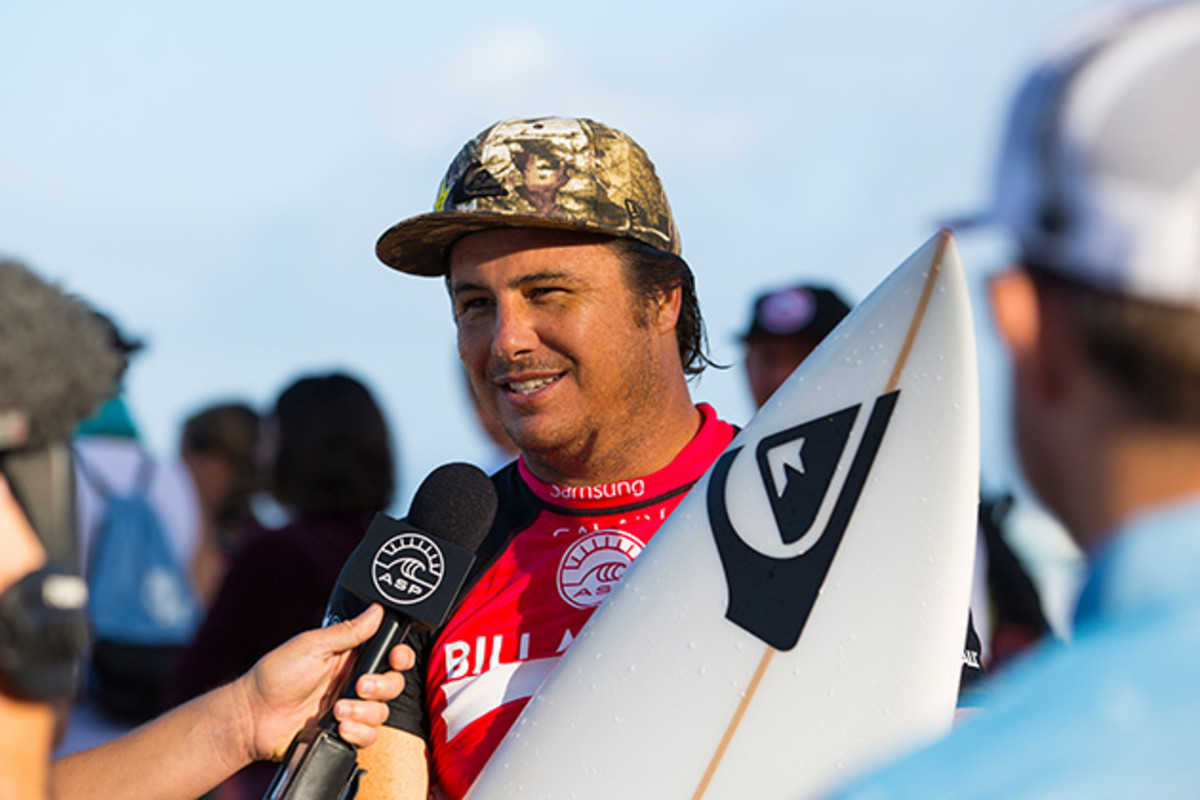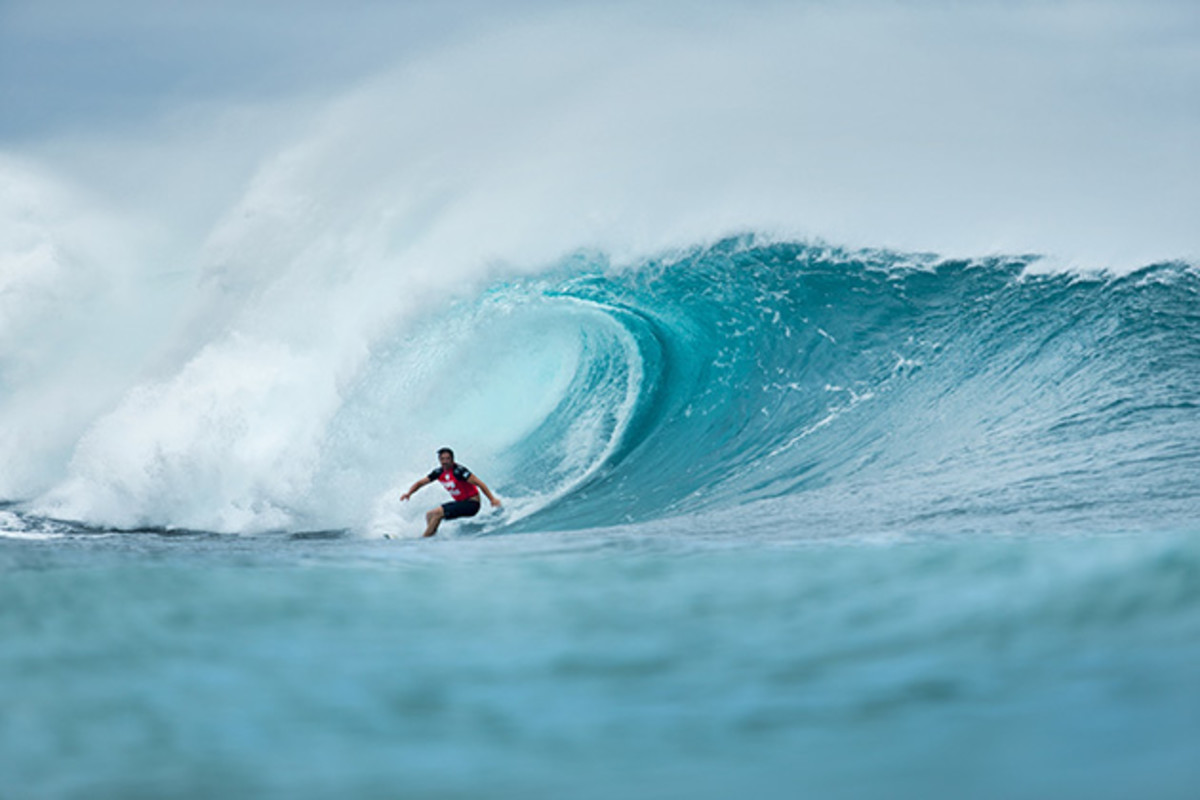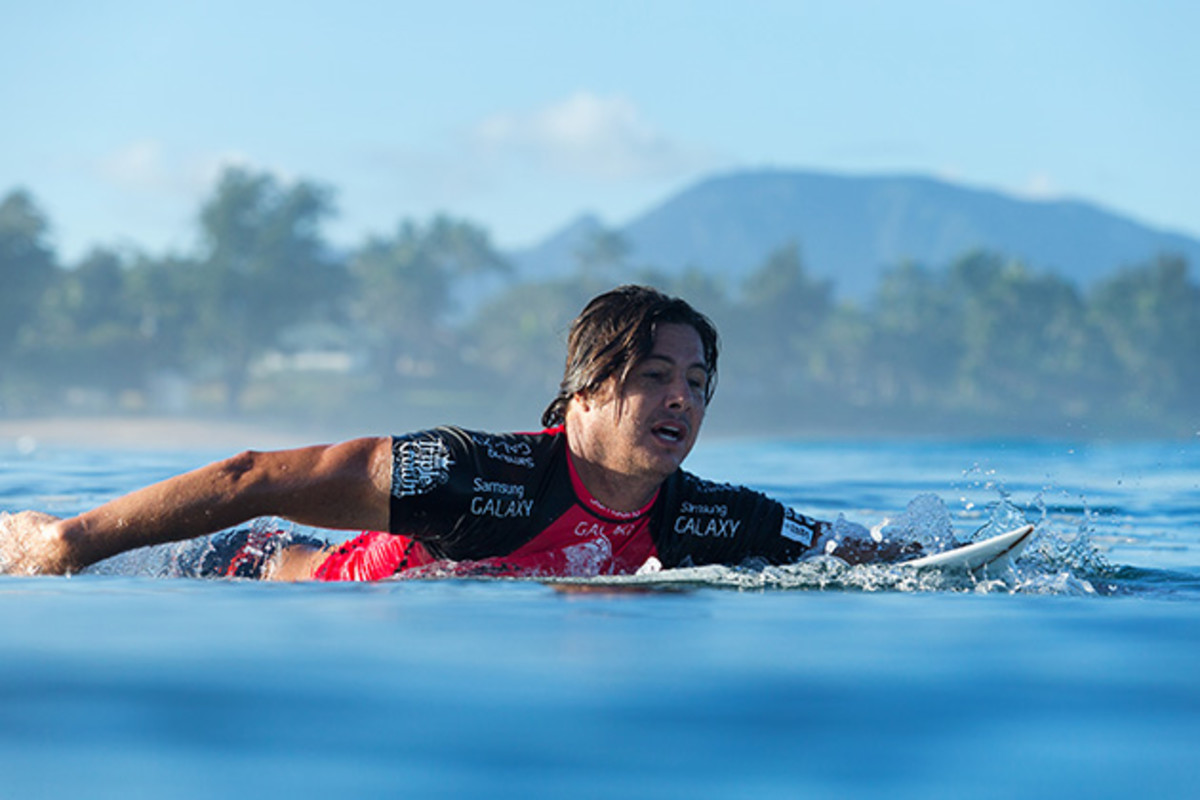Hey, bro, at the Pipeline, Quiksilver surfer Reef McIntosh runs the show

Michael February looks confused. The lanky 22-year-old professional surfer from South Africa has climbed the wooden steps from the beach to the backyard of a bungalow with green wooden siding. It’s early December on the North Shore of Oahu. The sun is punishing and the offshore trade winds buffet the Pacific, where February just surfed the most iconic wave in the world: the Banzai Pipeline. But it’s not the noise of the double overhead waves that sound like a rumbling train, nor is it the clanging of grandstands being built nearby for the Pipeline Masters contest that has February perplexed. His concern is more pressing.
He can’t find a place for his board.
No wonder. There’s a yellow tinted Channel Islands board on the front lawn. There are several broken boards stuffed into the crawl space under the bungalow. There are a dozen boards nestled under a rafter on the back deck. Inside, there are boards stacked on kitchen cabinets. Soft foam boards, bright-white boards, painted boards. There are 55 boards in the living room.
While February scans the backyard, Reef McIntosh approaches. Although February is 6' 3" McIntosh seems to tower over him.
Kieren Perrow reflects on career, transition to WSL commissioner role
“What do you need?” he asks.
February looks down at the Channel Islands MBM tucked under his arm, still dripping wet.
“Put it over there,” McIntosh says, gesturing at the bushes that separate the backyard from the beach and are festooned with boardshorts and wetsuit tops drying.
February follows the advice. When McIntosh speaks, others listen. He has earned that authority. For the past nine years, McIntosh, 39, has managed one of the most coveted locations in the surfing world—the Quiksilver House at Pipeline. The beachfront property that Quiksilver rents annually from October 1 to April 1, lodges up to seven team riders, including McIntosh. The house is also a gathering place as it is this afternoon for a barbecue before the opening ceremony of the Quiksilver in Memory of Eddie Aikau Big Wave Invitational.
While the 768-square-foot bungalow might seem unassuming compared to other beachfront abodes that span the Seven Mile Miracle, it’s the location that matters most—the 50-yard line of Pipeline, surfing’s biggest stadium. Conversations are often interrupted: “Look at this thing!”… “Check out that right! No the left!”… “It’s capping third reef,” and “Holy s---.”
And when the world’s best surfers aren’t in the lineup, they’re watching the action. Jamie O’Brien’s place and the Volcom house flank the property. Kelly Slater’s beachfront residence is a three-minute walk down Ke-Nui road from the Pipe House or Quik House, as most refer to it.

McIntosh prefers a different name.
It’s his house.
That sense of propriety is apparent this afternoon. When McIntosh isn’t tending to the steaks on the grill, he’s on the move. He checks the two coolers, makes sure there are enough chairs, and mingles with team riders and Quiksilver’s management, like co-founder and chairman, Bob McKnight. “All work, no surf,” McIntosh says. He has been up since 7 A.M. preparing everything. It’s now 2 P.M. He greets everyone who enters the backyard and explains the most important house rule: no shoes or sandals inside or even on the back deck.
“He likes to keep the house clean because we’re right in front of the beach and it’s a battle with the sand,” says Leo Fioravanti, an 18-year-old surfer from Italy who’s sponsored by Quiksilver and is staying at the house this winter—his ninth on the North Shore. “We all have house responsibilities and Reef makes sure we stick to the them.”
A whole new wave: Extreme Athletics takes surfing training indoors
.
The break where McIntosh excels the most is the one he can check from his bed.
In 2014, he won the Pipeline Invitational and earned a wildcard into the Pipe Masters, where he squared off against Gabriel Medina and Slater. In 2012, he took first place and $30,000 at the Da Hui Backdoor Shootout. On December 2, 2011, he pulled into a wave that looked more like a green cavern at Off the Wall, which breaks 50 yards west of Pipeline. He disappeared for four seconds then burst out of the wave’s spit. He didn’t claim it. He did win Surfline's Wave of the Winter and earned $25,000. A framed photo of his winning ride hangs in the living room.
“You don’t get paid to surf anywhere else in the world besides here,” McIntosh says. “I wouldn’t have a career without Pipeline.”
***
Unlike most of the surfers who dominate lineups on the North Shore, McIntosh is not a local. He was born in San Diego and learned to surf at four on the front of his father’s longboard. Laurence (Mac) McIntosh’s house overlooked Pacific Beach, so all his friends would leave their boards there. Reef would try every one before its owner returned.

. Reef was six when he relocated with his father.
The move was a “financial disaster.” Mac took jobs in construction and as a ranch hand for six years until he settled on carpentry.
“We were all broke, man,” says Mike Casey, a surfboard shaper who moved from California to the North Shore of Oahu in 1977. Casey shaped McIntosh’s first custom board for free.
While Kauai doesn’t receive the same acclaim as Oahu, it’s a breeding ground for surfing talent. Growing up, McIntosh’s peers included Dustin Barca, Danny Fuller, and the Irons brothers (Andy and Bruce). When McIntosh wasn’t traveling with his father to surf more challenging waves, he traded sets with the Irons at Pine Trees—the local break for the small town of Hanalei (pop. 450).
“They were phenoms,” Mac recalls of the Irons. “Reef had the skills in the real [heavy] surf, but he wasn’t winning contests like they were. They were unbeatable.”
John John Florence on his new surfing gear, filming and renewed dedication
At 14, McIntosh first traveled to the North Shore. He didn’t surf Pipeline. Instead he opted for less intimidating spots, like Rocky Point or Backyards.
“Liam [McNamara] did an air over my head and yelled at me,” he recalls from his first experience on Oahu. “That was an introduction.”
At 17, McIntosh returned during winter break from Kapa’a High School and stayed an extra an month, having convinced the school he was attending a funeral. The next year, he stayed the whole season, sleeping in the studio next to Mike Casey’s house at Backyards. But despite the hours he spent scratching for waves at Pipeline, he failed to land a sponsorship. He returned to Kauai and wasn’t sure about his next move. Maybe he should start apprenticing at a trade, as his father suggested. Maybe join the military.
Mac balks at the notion that he dissuaded his son from pursuing his dream and asserts that it was a financial reality.
“I encouraged him but I didn’t have the money or connections to put him on the North Shore for an extended time,” Mac says. “If Reef had stuck it out on Oahu he would have gotten sponsored earlier. He came back here because it was more comfortable. I told him his options and if you don’t make it as a pro surfer you can still have a good life.”
McIntosh disagreed. There were no other options. After all, it was only a matter of time until he’d get paid to surf the world’s best waves like his friends, right? But he needed a job in the meantime, so he tried construction, roofing, and carpentry like his dad. He landed a dishwashing gig at the Hanalei Wake-Up Café and advanced to lunchtime cook. He experienced another setback when he was 20 and suffered a compound fracture of his tibia and fibula while skateboarding—sidelining him for months.
“He was crushed,” Mac says. “He was watching everyone else making a living surfing and felt left out.”
But Lani Wattson, the owner of the Wake-Up, recognized McIntosh’s potential. She saw that Reef was always in the background, but just as good. She understood if he took a few hours off when the waves were pumping. She introduced him to Jeff Hakman, one of the founders of Quiksilver. Known as “Mr. Sunset,” Hakman was a regular at the Café whom Wattson knew from her time on the North Shore. She told Hakman, “this kid is the future.”
McIntosh started surfing with Hakman. When he wasn’t working, he traveled around the island looking for the best waves and got a friend to film every session. He put together a short highlight video, which he showed to Hakman and a few friends on the Café’s VCR.
During most of the video, Hakman was not impressed. Mac could tell by his expression. But in the final clip at a wave called Rifle Range on the South Shore of Kauai, McIntosh pulled into one barrel. Then another barrel. And another. The ride lasted over 300 yards. That caught Hakman’s attention. His eyes lit up.
Surfers excited to put all controversy behind them at Titans of Mavericks
“Where did you get that wave?” Mac remembers him asking. “It’s one of the best I’ve ever seen!”
McIntosh got sponsored by Quiksilver in 1999. He was 26—an age by which many surfing careers have already fizzled. Initially the deal was only for product. Even after working so long to get his shot, he had to prove himself at Pipeline. He knew it too. Once the video finished that morning at the Wake-Up Café, Hakman asked McIntosh what he wanted. His response? Six trips to the North Shore. He stayed at the Quiksilver house and put in his time learning the intricacies of Pipeline and gaining respect in the lineup.
“Reef is fearless,” says Eric Arakawa, one of the most renowned shapers on the North Shore, who has made McIntosh’s boards for eight years. “If there were no cameras on the beach, he still wants the biggest wave.”
McIntosh caught one of the best waves of the season in 2003. He gained a full-time sponsorship from Quiksilver. Then everyone knew his name (it’s pronounced MAC-intosh). Now the kid described as “quiet” and “introverted” opened up, realized his potential, and seized control of his surfing career. In 2007, he took over managing the house at Pipeline from Strider Wasilewski. Now when young team riders make the pilgrimage to the North Shore, it’s McIntosh who guides and watches over them.
***
Today’s Quiksilver team is an international group. Besides February and Fioravanti, there’s Noé Mar McGonagle (Costa Rica), Marc Lacomare (France), Mikey Wright (Australia), and Ramzi Boukhiam (Morocco), to name a few.
Still, McIntosh’s instructions, which usually begin with a variation of “hey bro,” transcend language or cultural barriers. The afternoon before the Eddie opening ceremony is no different.
“Hey bro,” he asks McGonagle, “Can you grab a can for the recycling?”
“Hey bro,” he tells Boukhiam after cleaning a folding table. “Can you take this to the garage?”
“Hey grom,” he informs Keanu Igarashi. “You’re not done with the dishes yet.”
“Hey,” he questions Kanoa Igarashi while drying off after a surf. “Is that your towel or a new one?”
McIntosh’s badgering is meant to do more than simply maintain order or keep the Quik house the cleanest on the strip. He’s proud of what he has achieved, loyal to the company that gave him a chance, and wants other team riders to share this respect.
“I call Reef the ‘blue collar pro’ when it comes to his sponsors,” Arakawa says. “He does what he’s asked to do and then goes above and beyond.”
McIntosh says he also hopes to impart “life lessons,” even if some of the team riders might get annoyed at times.
“When you are at home your parents take care of you,” he says. “But when you come here I am not your Dad or your Mom, so I’m not going to fold your clothes, or do your laundry for you, or cook your breakfast. I don’t care if you are getting paid a million dollars from Quiksilver, you’re gonna do the f------ dishes.”
The lessons extend beyond chores. Having spent 15 seasons working his way up the pecking order at Pipeline, McIntosh has gained an intimate knowledge of the break—which he spends “99.9 percent” of his time surfing while in Hawaii and describes in the feminine.
“You need to know her front and back,” McIntosh says. “You need to know her when she is two feet and crappy and when she is 20 feet and perfect. She is super moody, but if you work with her, she will reward you.”
He offers the same advice to all rookies on the North Shore. “Don’t go to Rockies, don’t go to V-land,” he says. “If you really want to make an impression and be confident at one of the world’s deadliest waves, you’ve got to put your time in. You’ve got to work her and massage her and treat her nice.”
Whitewater wizard Dane Jackson takes kayaking to another level
Broken boards are not the only testament of the spot’s power, where waves break in two feet of water over a razor sharp reef. Pipeline vexes, and injures, even the most accomplished surfers. Pipeline received national media attention on Dec. 6 when Evan Geiselman, a pro surfer from Florida, was rescued by world champion bodyboarder Andre Botha, after being knocked unconscious from hitting the reef and held under by a three-wave set. Three days later, Owen Wright, ranked fifth on the World Surf League tour, was hospitalized after wiping out and suffering “a severe concussion.” On Bede Durbidge’s first wave in round three of the Pipe Masters, he fell and was slammed against the reef. He fractured his pelvis in two places.
Carnage is a daily occurrence.
Around 1 P.M. on the day after the Eddie ceremony, Robbie McKnight, Bob McKnight’s son, stumbles into the backyard of the Quiksilver House and sits on the stoop of the deck. He’s clutching his right shoulder.
“The lip got me and popped it out,” he explains to Chad Wells, Quiksilver’s surf team manager.
“Does it hurt,” Wells asks.
“Yeah,” McKnight replies. “It f------ hurts.”
“Where’s Reef?” Wells wonders aloud.
McIntosh returns in four minutes. He’s accompanied by a lifeguard. “He can’t touch you but he can tell me how to do it,” McIntosh says.

His tone is not stressed, but calm. The atmosphere in the backyard is casual, as if everyone knows such injuries come with the territory.
“When you go home the chicks are all gonna ask what happened,” Fioravanti quips to McKnight. “You can be like, ‘Oh yeah, I pulled into a 10-foot wave at Pipe.”
After discussing possible methods to pop the shoulder back in (one is for McKnight to hold onto a cooler then have McIntosh yank his other arm), McKnight decides he doesn’t want assistance. He begins elevating his right arm. He grits his teeth. With every inch, the flesh on his shoulder twitches. He reaches 45 degrees. He lets out a soft groan.
He stops.
The pain is too intense.
McIntosh asks if he wants to see a doctor. McKnight nods. McIntosh leads him out of the backyard.
The two return an hour later, McKnight’s arm now covered in a black sling. Jackson Butler, a rail thin 13-year-old with blonde hair and freckles from Encinitas, Calif., stands on the left edge of the backyard with two boards at his feet. He glances at each like a golfer deciding between a 3-wood or a driver.
“Take the bigger one,” McIntosh offers. “You’re in Hawaii. You might never get to ride it at all.” Butler rubs some wax on the larger board. After McIntosh suggests where to paddle out, Butler walks over to the small metal gate in the right corner of the yard. There’s a problem. It doesn’t budge.
McIntosh notices. “Push,” he calls over. “Make sure to give it a little muscle.”
Butler tries again.
The gate opens.
